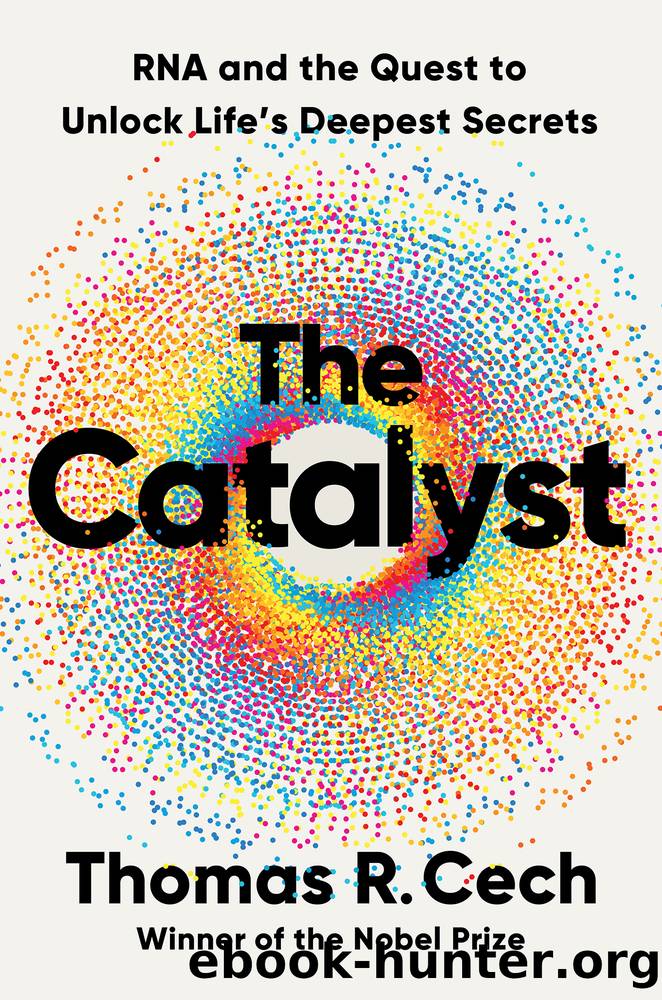The Catalyst by Thomas R. Cech

Author:Thomas R. Cech
Language: eng
Format: epub
Publisher: W. W. Norton & Company
A GUIDING STAR IN ORIONâS BELT
In the same year he found human microRNAs, Tom Tuschl discovered that it only took a small double-stranded RNA, the length of about 21 base pairs, to shut down gene expression. In other words, it wasnât necessary to treat cells with double-stranded RNA molecules that were hundreds of base pairs longâas scientists had been doing since they first heard about Andy Fire and Craig Melloâs workâand then let Dicer cut that RNA down to size. Instead, they could just provide the short double-stranded RNA directly. Critically, because Tom had been trained by the pioneering nucleic acid chemist Fritz Eckstein in Göttingen, he was able to produce these RNAs by chemical synthesis. And if siRNAs could be chemically synthesized, they started to look a lot like drugs. Tom had laid the scientific groundwork for turning RNA into a therapeutic agent that could target mRNA arising from harmful genes.
In 2002, Tom Tuschl, Phil Sharp, and former Sharp lab colleagues Dave Bartel and Phil Zamore founded Alnylam Pharmaceuticals. Alnylam (or Alnilam) is the bright star in the belt of the constellation Orion, and just as Polaris points the way to the north, this star in Orion would hopefully aim the company at a whole new class of therapeutics.
What made siRNAs so attractive as potential therapeutic agents? Consider that development of any potential drug requires sorting out a host of questions, including: How specific is it for its target relative to healthy processes that might also be affected? What are its side effects, and can they be tolerated? Whatâs the effective therapeutic dose? How often does it have to be taken? Traditional pharmaceuticals are small organic molecules, such as the aspirin we take for aches and pains or atorvastatin (Lipitor), which we take to lower our cholesterol levels. For such drugs, answering all the questions about safety and efficacy is a long and expensive research and development project, which must begin anew for every new molecule. Thereâs a good chance that a drug will fail before surmounting all these hurdles. In theory, siRNA could vastly simplify this process. Certainly, the first time around it still presents numerous challenges: stabilizing the siRNA, figuring out how to deliver it to the relevant tissues in the body, and ensuring that it is safe and effective. But once these problems are solved for one application, then targeting a new disease could be as simple as changing the sequence of A, U, G, and C bases along the siRNA to match the new mRNA. The issues of stability, delivery, and safety would to a great extent already be âpreapproved.â
Alnylam chose to attack the problem of rare diseases, defined as diseases that affect fewer than 200,000 people in the United States. These are also known as âorphan diseases,â because the patient population isnât big enough for pharmaceutical companies to deem it worthwhile to spend the billion dollars it takes to develop a drug and run it through human clinical trials. But in the aggregate, orphan diseases represent an enormous unmet medical need.
Download
This site does not store any files on its server. We only index and link to content provided by other sites. Please contact the content providers to delete copyright contents if any and email us, we'll remove relevant links or contents immediately.
Sapiens: A Brief History of Humankind by Yuval Noah Harari(14322)
The Tidewater Tales by John Barth(12627)
Mastermind: How to Think Like Sherlock Holmes by Maria Konnikova(7281)
Do No Harm Stories of Life, Death and Brain Surgery by Henry Marsh(6908)
The Thirst by Nesbo Jo(6882)
Why We Sleep: Unlocking the Power of Sleep and Dreams by Matthew Walker(6659)
Life 3.0: Being Human in the Age of Artificial Intelligence by Tegmark Max(5520)
Sapiens by Yuval Noah Harari(5325)
The Longevity Diet by Valter Longo(5044)
The Body: A Guide for Occupants by Bill Bryson(5033)
The Rules Do Not Apply by Ariel Levy(4912)
The Immortal Life of Henrietta Lacks by Rebecca Skloot(4552)
Animal Frequency by Melissa Alvarez(4430)
Why We Sleep by Matthew Walker(4395)
The Hacking of the American Mind by Robert H. Lustig(4342)
Yoga Anatomy by Kaminoff Leslie(4335)
All Creatures Great and Small by James Herriot(4277)
Double Down (Diary of a Wimpy Kid Book 11) by Jeff Kinney(4244)
Embedded Programming with Modern C++ Cookbook by Igor Viarheichyk(4144)
